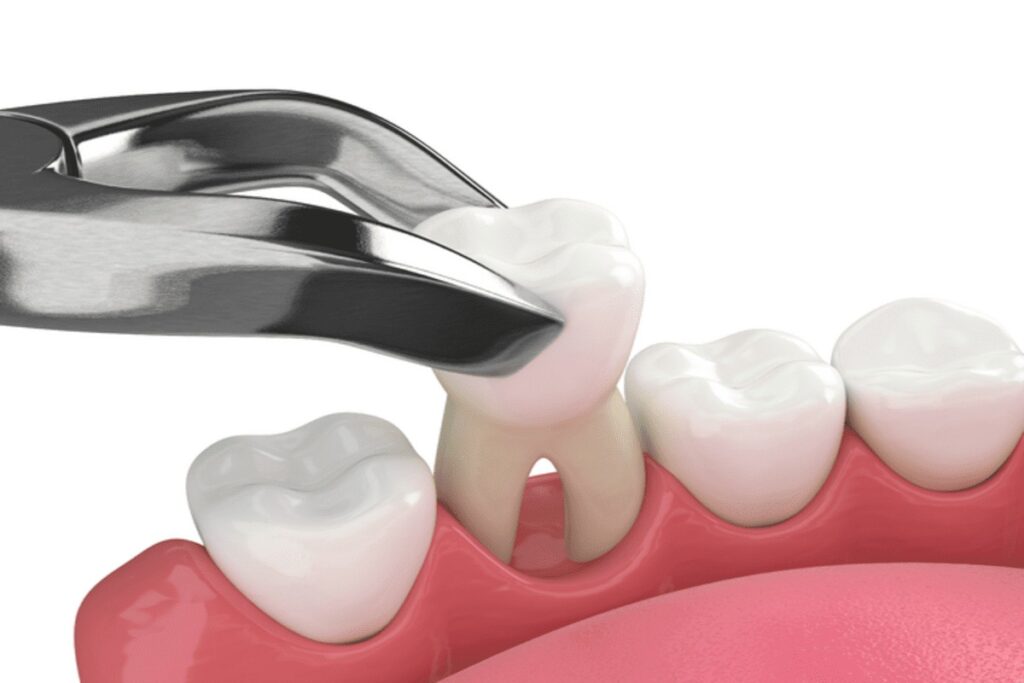A tooth is detached from its socket in the maxilla or mandible jawbone. Commonly known as tooth extraction, this office-based dentist surgery is best for treating common oral health conditions. When decay or infection has progressed beyond root canal therapy, teeth may need removal.
In cases of severe injuries, teeth may need removal. Dental crowding can be prevented or relieved through extractions. It includes the removal of wisdom teeth (third molars) that lack space for eruption, adult teeth that overcrowd a narrow jawbone, and persistent baby teeth that refuse to relax even when their permanent replacements appear.
Understanding Tooth Extraction: Reasons and Types
Unfortunately, fillings and root canals may not save a tooth with extensive decay or infection; thus, extraction is important to stop infection. Wisdom teeth often don’t fully erupt from the gum tissue. Impacted teeth may cause pain, infection, or damage to adjoining teeth, requiring extraction.
Orthodontists may recommend tooth extraction in West Edmonton to create enough room for the remaining teeth to align properly. Crowding: When the oral cavity is too crowded, teeth may need to be extracted. Accidental or sports-injured teeth may need extraction if they cannot be repaired.
As dental professionals will tell you, there are two main tooth extractions:
A simple extraction gently removes a visible, reachable tooth. Specialized dental devices gently loosen the tooth before the dentist or oral surgeon carefully extracts it. For impacted or shattered teeth, surgical extraction is a complex procedure. An incision in the gum and bone removal may be needed to extract the tooth.
Preparing for Tooth Extraction: What to Expect
Before extracting your tooth, the dentist will review your medical and dental records to understand your oral health. The dentist will also take multi-angle digital X-rays of the treatment area. Radiographs show the dental root’s size, shape, and orientation in its alveolar socket and skeletal structure.
They can reveal dental root and socket closeness. The dentist can carefully schedule your tooth extraction near you using these radiological pictures. Radiographs of complicated extractions may suggest an oral surgeon referral.
The dentist may prescribe antibiotics before the dental operation if you are immunocompromised or have a heart condition. Antibiotics before surgery, which can introduce a lot of bacteria into your system, prevent infection in many regions of your body, including your heart. If your extraction requires IV or general anesthesia or medication to reduce dental anxiety, you must arrange for a responsible driver.
Post-Extraction Care: Recovery and Healing
After removing your tooth, the dentist carefully cleans the socket walls to remove infected or pathologic tissue. Next, the dentist gently presses the socket to its original size. They expertly polish rough bone edges for a comfortable healing procedure.
They also painstakingly clean the region, eliminating tooth and bone fragments. After cleaning and disinfecting the socket, sutures should be used to close it. It will promote maximum recovery. Not all extractions require sutures.
Next, the skilled dentist near you delicately places a piece of sterile gauze over the extraction site and instructs you to bite down on it for 30–45 minutes. It stops dental socket bleeding and promotes blood clotting. The dentist generously provides post-extraction care advice to reduce infection, pain, and healing time before you leave. Most people can resume normal activities within 48–72 hours of dental surgery.
Replacing Extracted Teeth: Restorative Options
Dear patient, dental implants are beautiful titanium posts that are meticulously placed into the jawbone to replace tooth roots. For stability and lifespan, they support crowns, bridges, and dentures. Fixed bridges with pontics are great dental restorations.
For stability, the dentist in West Edmonton attaches pontics to your natural teeth or dental implants. It replaces missing teeth. The gum-coloured foundation of removable partial dentures holds synthetic teeth. Many tooth prostheses restore function and beauty.
Cleaning and maintaining removable dentures is simple. Beautiful detachable complete dentures replace all teeth in an upper or lower arch. If all teeth are lost, implants can help. Maryland bridges carefully attach artificial teeth to natural teeth while preserving their structure.
They are usually used on the front teeth. Complete dentures with teeth are more stable than implant-supported dentures. Implants maintain removable partial dentures.
Talk to Our Dentist and Get Started Today
Tooth extraction is much less traumatic than the average person would imagine. The key is to locate a competent dental practitioner in your area. Aftercare is equally as crucial as the treatment itself, so keep that in mind. To avoid issues, stick to the dentist’s orders.
If you have any questions or would like to arrange an appointment, visit Aldergrove Dental Clinic! We’re here to assist!

